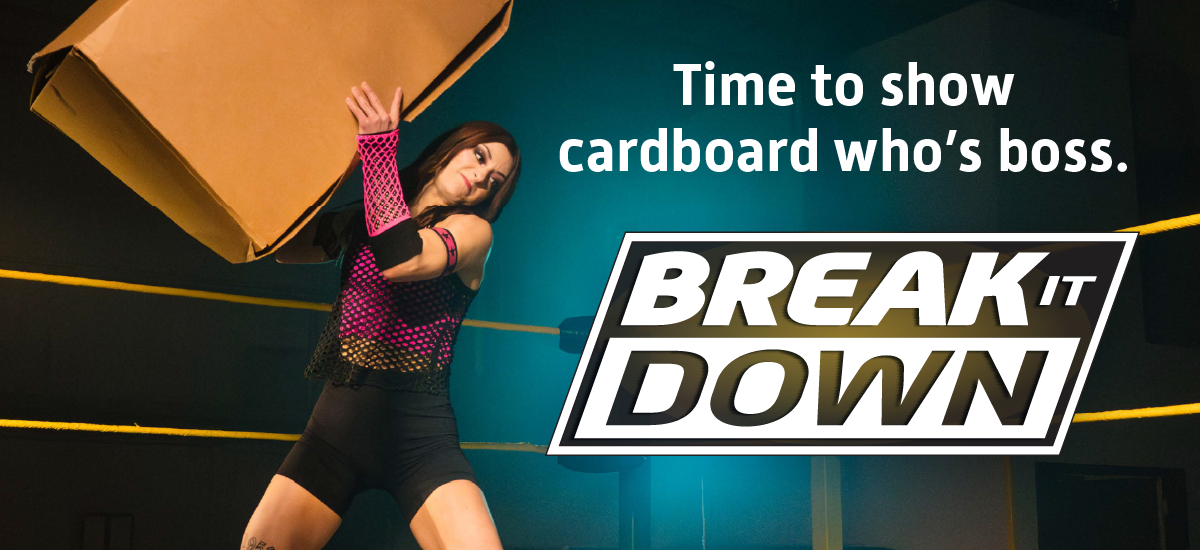Cardboard Recycling

Break It Down: Recycling Right Starts Here
Every cardboard box you recycle has the potential to be turned into something new, but only if it’s recycled right. That starts with one easy action: Break it down.
Flattening your boxes before recycling isn’t just a suggestion, it’s essential. When boxes are left whole, they hog space, block lids from closing and can lead to contamination that sends good recycling straight to the landfill.
For Residents: Do Your Part at Home
Why It Matters
Your blue cart or bin is designed to handle a lot but not when it’s overflowing with bulky boxes. When you break down your boxes, you:
- Create more space for other recyclables.
- Prevent litter from loose items spilling out.
- Keep your recycling clean and dry by ensuring the lid closes properly.
- Prevent other non-cardboard recyclable items from getting stuck inside of cardboard boxes and contaminating the cardboard collected.
At the Depot
Recycling depots are shared community spaces. When bins overflow with bulky boxes, it creates mess, frustration and extra work. Flatten your boxes before you drop them off. If the bins are full, please come back later. Your effort helps keep the depot clean and efficient for everyone. Flat is where it’s at!
For Businesses: Smart Recycling Starts with You
Efficiency, Compliance and Cost Savings
In a busy workplace, recycling can be an afterthought, but it shouldn’t be. Flattening cardboard boxes:
- Maximizes bin capacity, reducing how often you need pickups.
- Lowers your waste management costs by avoiding overage fees.
- Supports compliance with local business waste bylaws.
Make it part of your team’s routine. Post signage, train staff and lead by example. Ensure they have the right tools, like box cutters, gloves or safety shears for breaking down tougher boxes. A few seconds spent flattening boxes can save time, money and hassle down the line.
The Cost of Not Breaking It Down
When boxes aren’t broken down:
- Lids stay open, letting in rain, snow and debris. Closed lids can also help deter vandalism and illegal dumping.
- Wet or dirty cardboard becomes contaminated and can’t be recycled.
- Contaminated loads are often rejected at recycling facilities and sent to landfill.
- Overflowing bins can lead to missed collections, community complaints, and increased costs for everyone.
- Garbage is more expensive to collect than recycling. Properly recycling cardboard and right-sizing your waste containers can help reduce your overall waste costs.
How to Break It Down Right
- Remove any packing materials (plastic wrap, foam, etc.).
- Flatten the box completely. Step on it if needed!
- Stack it neatly in your cart, bin or depot container.
- Close the lid to keep your recycling clean and dry.
Break it down. Because recycling right starts with you.
Break It Down: Recycle Your Boxes Right
| Break It Down: Recycle Your Boxes Right
|
|---|
FREQUENTLY ASKED QUESTIONS
Are there guidelines for recycling cardboard in my blue cart?
Large appliance boxes should be cut down into smaller to 2’ x 2’ pieces so that they fit in blue cart.
Remove as much tape and staples as possible, but as long as the non-cardboard material on the box makes up less than 2% of the volume it will not affect the box’s ability to be recycled.
Avoid filling cardboard boxes with other recyclable materials as the contents can get compacted and stuck together in the box and contaminate the cardboard recycling stream.
Do I need to remove tape and stickers from cardboard boxes before recycling them?
No, small amounts of tape and labels are okay. Most recycling facilities can handle them during processing. However, try to remove large sections of plastic tape or non-paper stickers when possible.
Can I recycle cardboard material mailing envelopes?
Yes, if they’re made entirely of paper or cardboard. If the envelope has a plastic lining or bubble wrap inside, it’s not recyclable and should go in the garbage.
Can I recycle Styrofoam packaging that comes inside boxes to protect electronics or appliances?
No, Styrofoam is not accepted in curbside recycling or at the recycling depots. It can, however, be recycled at SARCAN.
What should I do with oversized boxes for large appliances that don’t fit in my blue bin?
Flatten them as much as possible and take them to a recycling depot. If you’re unable to transport them, consider cutting them down into smaller pieces that fit in your cart or bin.
If boxes have a bit of dirt or food on them, can they still be recycled?
No. Boxes with food residue, grease or heavy dirt are considered contaminated and should go in the garbage. Clean, dry cardboard is best for recycling. The good news is, food soiled cardboard CAN be composted so put it in your organics collection (if you have it).
If I've turned a box into an art project, can it still be recycled?
It depends. If the box is covered in paint, glue, glitter, or other non-paper materials, it’s no longer recyclable. If it’s mostly clean and decorated with paper-based materials, it can be recycled.
Can I put a cardboard box that is filled with other recyclable materials into the recycling bin?
No. Boxes should be emptied before recycling. Leaving items inside makes sorting difficult and can lead to contamination. Always empty, flatten, and then recycle your boxes.
